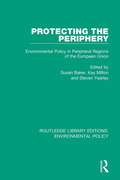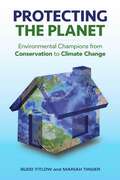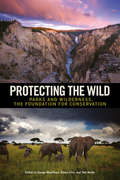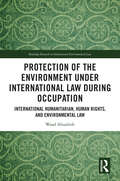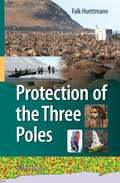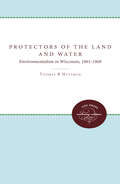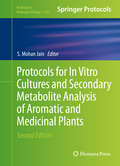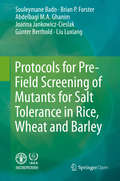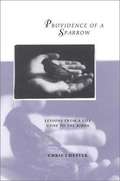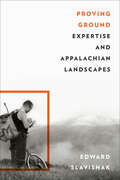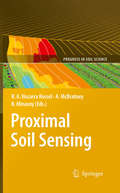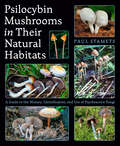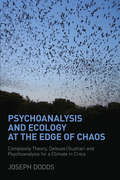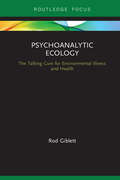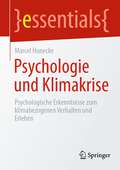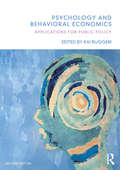- Table View
- List View
Protecting the Periphery: Environmental Policy in Peripheral Regions of the European Union (Routledge Library Editions: Environmental Policy #1)
by Steven Yearley Susan Baker Kay MiltonFirst published in 1994. ln Protecting the Periphery the editors present a series of papers revealing the impact of EU policies on environmental quality in regions at the edge of the European Union and in those lying just outside it. In many cases these regions contain habitats and landscapes of international importance; they have also often escaped some of the environmental damage caused by industrialization. But, as the papers' reveal, attempts by the EU to safeguard these environmental benefits are often contradicted by the EU’s own development policies, bringing air pollution from new roads, contamination from new industries, and leading to habitat destruction from modern agricultural practices and increases in tourism. As the Union pushes for the deepening of the integration process, including completing the internal market, the pressures on the periphery's environment are increasing. Furthermore, the efforts of the periphery to catch-up economically with the developed core can often heighten the tension between economic considerations on the one hand and the need for environmental protection on the other. The studies in this book examine the ambivalent responses to EU environmental policy among policy-makers and environmentalists in the periphery. Both the willingness as well as the capacity of the periphery to protect its environmental heritage are explored. In particular, the administrative capacity, institutional arrangements, political culture as well as economic development needs are taken into account in an examination of the nature of the periphery’s response to and implementation of Union environmental policy. The book will appeal to policy-makers and academics in the countries of the European periphery and to analysts of European policy-making everywhere, especially those concerned with environmental policy and politics.
Protecting the Planet: Environmental Champions from Conservation to Climate Change
by Budd Titlow Mariah TingerClimate change is often associated with predictions of dire calamities. But in the past, heroic individuals have stepped forward to meet even the most ominous ecological challenges. This book tells an inspirational story—a story both of pioneering environmentalists who raised our collective consciousness regarding nature's value and heroes of today who are working to secure a sustainable future. The authors begin with the mounting evidence for climate change as seen in rising carbon dioxide levels, higher global temperatures, melting ice sheets, and sea level rise. They then review the history of the US environmental movement, focusing on the key people who changed our understanding of the human impact on our natural surroundings. These include John James Audubon, Henry David Thoreau, John Burroughs, Theodore Roosevelt, John Muir, Bob Marshall, Roger Tory Peterson, Aldo Leopold, Rachel Carson, David Brower, Barry Commoner, Donella Meadows, and many more. Turning to the present, the authors recount the activities of people currently pursuing remedies for climate change—scientists, researchers, activists, artists, and celebrities. Much of this information is based on recent personal interviews. They conclude with a set of actionable strategies, demonstrating that there are good reasons to hope that we can achieve a sustainable lifestyle, protect our planet as our home, and ensure the future for our children.
Protecting the Wild
by Tom Butler George Wuerthner Eileen CristProtected natural areas have historically been the primary tool of conservationists to conserve land and wildlife. These parks and reserves are set apart to forever remain in contrast to those places where human activities, technologies, and developments prevail. But even as the biodiversity crisis accelerates, a growing number of voices are suggesting that protected areas are passé. Conservation, they argue, should instead focus on lands managed for human use--working landscapes--and abandon the goal of preventing human-caused extinctions in favor of maintaining ecosystem services to support people. If such arguments take hold, we risk losing support for the unique qualities and values of wild, undeveloped nature. Protecting the Wild offers a spirited argument for the robust protection of the natural world. In it, experts from five continents reaffirm that parks, wilderness areas, and other reserves are an indispensable--albeit insufficient--means to sustain species, subspecies, key habitats, ecological processes, and evolutionary potential. Using case studies from around the globe, they present evidence that terrestrial and marine protected areas are crucial for biodiversity and human well-being alike, vital to countering anthropogenic extinctions and climate change. A companion volume to Keeping the Wild: Against the Domestication of Earth, Protecting the Wild provides a necessary addition to the conversation about the future of conservation in the so-called Anthropocene, one that will be useful for academics, policymakers, and conservation practitioners at all levels, from local land trusts to international NGOs.
Protecting the Wild: Parks and Wilderness, the Foundation for Conservation
by Tom Butler George Wuerthner Eileen CristProtected natural areas have historically been the primary tool of conservationists to conserve land and wildlife. These parks and reserves are set apart to forever remain in contrast to those places where human activities, technologies, and developments prevail. But even as the biodiversity crisis accelerates, a growing number of voices are suggesting that protected areas are passé. Conservation, they argue, should instead focus on lands managed for human use--working landscapes--and abandon the goal of preventing human-caused extinctions in favor of maintaining ecosystem services to support people. If such arguments take hold, we risk losing support for the unique qualities and values of wild, undeveloped nature. Protecting the Wild offers a spirited argument for the robust protection of the natural world. In it, experts from five continents reaffirm that parks, wilderness areas, and other reserves are an indispensable--albeit insufficient--means to sustain species, subspecies, key habitats, ecological processes, and evolutionary potential. Using case studies from around the globe, they present evidence that terrestrial and marine protected areas are crucial for biodiversity and human well-being alike, vital to countering anthropogenic extinctions and climate change. A companion volume to Keeping the Wild: Against the Domestication of Earth, Protecting the Wild provides a necessary addition to the conversation about the future of conservation in the so-called Anthropocene, one that will be useful for academics, policymakers, and conservation practitioners at all levels, from local land trusts to international NGOs.
Protection of Global Biodiversity: Converging Strategies
by Jeffrey Mcneely Lakshman D. GuruswamyThe rate of extinction of biological species is greater today than at any time in the last 65 million years. Some predict that if this rate continues, two-thirds of all living species will disappear during the next century. Because reaching consensus on specific courses of action involves complex issues, any adequate response to this impending crisis must include coverage of many areas of inquiry and understanding. Protection of Global Biodiversity features essays by distinguished international experts who communicate with each other across disciplinary boundaries to address the challenge of formulating policies to protect biodiversity.Although the global community has recently adopted a Convention of Biological Diversity, the agreement sets forth only abstract goals. Contributors to this volume advance the Convention's initial steps by providing workable solutions that can be implemented regionally, nationally, and locally. The contributors--including natural, social, and political scientists; economists; lawyers; and environmentalists; and decisionmakers in business, agriculture, and government--have united to create a common discourse and to evaluate and propose strategies for halting this alarming loss of biodiversity. In recognizing the diverse aspects of this task--scientific, economic, institutional, moral, and legal--this book presents a new picture of emerging action.Contributors. S. James Anaya, Gregory Benford, Graciela Chichilnisky, S. Todd Crider, Yvonne Cripps, Robert T. Fraley, Anil K. Gupta, Lakshman D. Guruswamy, G. M. Heal, Brent Hendricks, Robert B. Horsch, Laura L. Jackson, Annie Lovejoy, Ariel E. Lugo, Jeffrey A. McNeely, Brian G. Norton, Elinor Ostrom, Peter H. Raven, John W. Reid, Walter V. Reid, Mark Sagoff, Roger A. Sedgo, R. David Simpson, Ana Sittenfeld, Christopher D. Stone, Gary H. Toenniessen
Protection of the Environment under International Law during Occupation: International Humanitarian, Human Rights and Environmental Law (Routledge Research in International Environmental Law)
by Waad AbualrobThis book examines the relationship between International Environmental Law and Human Rights Law regarding the protection of the environment in times of occupation.Times of occupation create a tangible threat to the environment, alongside human, animal, and plant rights. This book uses international law to grapple with unprecedented environmental challenges, from water, air and soil pollution and severe damage to natural resources to the complexities of regulating emerging environmental challenges during extraordinary situations. Using international case studies alongside the prominent and evolving role of international law agreements, in particular Multilateral Environmental Agreements (MEAs), this book offers a comprehensive analysis of the legal tools available to navigate environmental challenges under occupation. The book also discusses occupying power obligations under public international law and the demands of protecting the environment in occupied territory.The book provides a valuable resource for researchers in the field of environmental law, human rights law, and humanitarian law.
Protection of the Three Poles
by Falk HuettmannThe Arctic, the Antarctic, and the Hindu Kush-Himalayas form a trio of terrains sometimes called "the three poles". Mainly composed of rock, snow, and ice, these precious regions, which are home to many unique species such as the polar bear, the emperor penguin, and the snow leopard, contain the primary water resource of this planet and directly shape our climate. This book presents a first-ever global assessment and progressive review of the three poles and demonstrates the urgent need for their protection. Sins of the past have irrevocably harmed and threatened many of the unique qualities of these regions, and the future looks bleak with the global population forecast to reach 9 billion by 2060, and with climate change on the rise. Presented here is a wide-reaching and coherent overview of the three poles' biodiversity, habitats, and ongoing destruction. Failed protection and social targets set by the United Nations and other bodies are exposed while economic growth, unconstrained or inappropriate development, and urban sprawl are promoted unabated. Polar regions play a major role in the global agenda as they are rich in oil and other resources, marking them for contamination, overfishing, and further degradation. Tourism in the Antarctic has benefited from enlightened self-regulation, but there are signs that this is changing, too. The chapters of this book are written by experts in their fields, and their evidence leaves no doubt that we already live beyond our carrying capacity on a finite but decaying space. A global protection role model and several outlook scenarios are proposed to help set in motion polar protection priorities that are actually valid. Humanity has demonstrated through international treaties such as the Antarctic Treaty and the Madrid Protocol that we can put the interests of the planet as a whole first. This must become the norm, not the exception.
Protectors of the Land and Water: Environmentalism in Wisconsin, 1961-1968
by Thomas R. HuffmanSince the beginning of the twentieth century, Wisconsin citizens have promoted innovative environmental programs. During the 1960s Wisconsin was again at the forefront of the movement advancing mainstream political environmentalism. Thomas Huffman traces the rise of environmentalism in the Badger State during these key years, when the people of Wisconsin instituted policies in such areas as outdoor recreation and resource planning, water pollution control, the preservation of wild rivers, and centralized environmental management. Huffman focuses especially on the influence of Senator Gaylord Nelson, a Democrat and founder of Earth Day, and Governor Warren Knowles, a Republican. He shows that their efforts--and the efforts of their followers in citizen groups, the business and university communities, and the state government--clearly indicate that the origins of environmentalism cannot be placed along a left-right political spectrum. Rather, the movement evolved from an interweaving of liberal and conservative ideologies and from important traditions and precedents within the state's environmental culture. What happened in Wisconsin is particularly significant, Huffman points out, because of the effect of that state's example on other states and the federal government.Originally published in 1994. A UNC Press Enduring Edition -- UNC Press Enduring Editions use the latest in digital technology to make available again books from our distinguished backlist that were previously out of print. These editions are published unaltered from the original, and are presented in affordable paperback formats, bringing readers both historical and cultural value.
Protest-Aktivist*innen der Umweltschutz-Bewegung im Netz und auf der Straße: Voraussetzungen und Motive für Partizipation (Medien der Kooperation – Media of Cooperation)
by Lisa VilliothDieses Open-Access-Buch untersucht mit Fokus auf einzelne Bürger*innen fallspezifisch und empirisch den Handlungs- und Wirkungszusammenhang von Straßenprotest und Online-Aktivismus im Bereich der Umweltschutz-Bewegung. Eine ganze Bandbreite von Online- und Offline-Protestpraktiken erlaubt es Bürger*innen heutzutage, sich in politische Prozesse einzumischen, Öffentlichkeit für bestimmte Themen zu erzeugen und Politiker*innen und Unternehmen unter Druck zu setzen. Online ist hierbei jedoch nicht zwangsläufig Ersatz für Offline. In vielen Situationen von Protestpartizipation ergänzen sich Elemente beider Sphären. Warum entschließen sich Bürger*innen, ganz spezifischen Praktiken – online wie offline – nachzugehen und anderen Praktiken nicht? Welche Vor- und Nachteile benennen sie für die einzelnen ihnen zur Verfügung stehenden Formate? Die Arbeit steht im Schnittfeld unterschiedlicher politikwissenschaftlicher Forschungsfelder wie der Protestforschung, der politischen Partizipationsforschung und der Forschung rund um das Thema Digitalisierung. Basierend auf 18 Leitfaden-Interviews und einer ausführlichen Analyse werden sechs Typen von Protest-Aktivist*innen gebildet.
Protocols for In Vitro Cultures and Secondary Metabolite Analysis of Aromatic and Medicinal Plants, Second Edition
by S. Mohan JainThis volume provides a detailed step-by-step description of protocols for the establishment of in vitro cultures of important medicinal plants, their mass multiplication in controlled environment, and step-wise secondary metabolite analysis. Many of these protocols also provide a basis for in vitro germplasm conservation or cryopreservation of medicinal plant species. Written for the Methods in Molecular Biology series, chapters include introductions to their respective topics, lists of the necessary materials and reagents, step-by-step, readily reproducible laboratory protocols, and tips on troubleshooting and avoiding known pitfalls. Authoritative and practical, Protocols for In Vitro Cultures and Secondary Metabolite Analysis of Aromatic and Medicinal Plants, Second Edition aims to ensure successful results in the further study of this vital field.
Protocols for Pre-Field Screening of Mutants for Salt Tolerance in Rice, Wheat and Barley
by Souleymane Bado Brian P. Forster Abdelbagi M. A. Ghanim Joanna Jankowicz-Cieslak Günter Berthold Liu LuxiangThis book offers effective, low-costand user-friendly protocols for the pre-field selection of salt-tolerant mutants in cereal crops. It presents simple methods for measuring soil salinity, includingsoil sampling and the analysis of water-soluble salts, and describes adetailed, but simple, screening test for salt tolerance in rice, wheat andbarley seedlings, which uses hydroponics. The protocols are devised for use byplant breeders and can be easily accommodated into breeding practice.
Proud to Be Right: Voices of the Next Conservative Generation
by Jonah GoldbergIn Proud to Be Right, Jonah Goldberg, the New York Times bestselling author of Liberal Fascism, presents voices of the next Conservative generation. A fresh and provocative collection of lively political writing from right wing writers under the age of 30, Proud to Be Right rebuts the conventional wisdom that Generation Y is a uniformly liberal demographic—and that intelligent young people today fall blindly into the Barack Obama camp.
Providence of a Sparrow: Lessons from a Life Gone to the Birds
by Chris ChesterHouse sparrow "B" fell twenty-five feet from his nest into the life of Chris Chester. The encounter was providential for both of them. B and Chester spent hours together playing games like bottle-cap fetch or hide-and-seek. They learned "words" in each other's vocabularies. B developed a fetish for nostrils and a dislike of the color yellow. He grew anxious if Chester came home late from work. At bedtime he would rub his sleepy eyes on Chester's thumb and settle to sleep in his palm. Chester ended up turning part of his house into an aviary and adjusting his social life to meet B's demands. This was a small price to pay, though, for the trust and comfort of a twenty-five-gram friend who brought joy and wonder back into his life.
Proving Ground: Expertise and Appalachian Landscapes
by Edward SlavishakDisrupting the intervenor narrative in Appalachian studies.The Appalachian Mountains attracted an endless stream of visitors in the twentieth century, each bearing visions of what they would encounter. Well before large numbers of tourists took to the mountains in the latter half of the century, however, networks of missionaries, sociologists, folklorists, doctors, artists, and conservationists made Appalachia their primary site for fieldwork. In Proving Ground, Edward Slavishak studies several of these interlopers to show that the travelers’ tales were the foundation of powerful forms of insider knowledge. Following four individuals and one cohort as they climbed professional ladders via the Appalachian Mountains, Slavishak argues that these visitors represented occupational and recreational groups that used Appalachia to gain precious expertise. Time spent in the mountains, in the guise of work (or play that mimicked work), distinguished travelers as master problem-solvers and transformed Appalachia into a proving ground for preservationists, planners, hikers, anthropologists, and photographers.Based on archival materials from outdoors clubs, trade journals, field notes, correspondence, National Park Service records, civic promotional materials, and photographs, Proving Ground presents mountain landscapes as a fluid combination of embodied sensation, narrative fantasy, and class privilege. Touching on critical regionalism and mobility studies, this book is a boundary-pushing cultural history of expertise, an environmental history of the Appalachian Mountains, and a historical geography of spaces and places in the twentieth century.
Proximal Soil Sensing
by Alex B. Mcbratney Budiman Minasny Raphael A. Viscarra RosselThis book reports on developments in Proximal Soil Sensing (PSS) and high resolution digital soil mapping. PSS has become a multidisciplinary area of study that aims to develop field-based techniques for collecting information on the soil from close by, or within, the soil. Amongst others, PSS involves the use of optical, geophysical, electrochemical, mathematical and statistical methods. This volume, suitable for undergraduate course material and postgraduate research, brings together ideas and examples from those developing and using proximal sensors and high resolution digital soil maps for applications such as precision agriculture, soil contamination, archaeology, peri-urban design and high land-value applications, where there is a particular need for high spatial resolution information. The book in particular covers soil sensor sampling, proximal soil sensor development and use, sensor calibrations, prediction methods for large data sets, applications of proximal soil sensing, and high-resolution digital soil mapping. Key themes: soil sensor sampling - soil sensor calibrations - spatial prediction methods - reflectance spectroscopy - electromagnetic induction and electrical resistivity - radar and gamma radiometrics - multi-sensor platforms - high resolution digital soil mapping - applications Raphael A. Viscarra Rossel is a scientist at the Commonwealth Scientific and Industrial Research Organisation (CSIRO) of Australia. Alex McBratney is Pro-Dean and Professor of Soil Science in the Faculty of Agriculture Food & Natural Resources at the University of Sydney in Australia. Budiman Minasny is a Senior Research Fellow in the Faculty of Agriculture Food & Natural Resources at the University of Sydney in Australia.
Psilocybin Mushrooms in Their Natural Habitats: A Guide to the History, Identification, and Use of Psychoactive Fungi
by Paul StametsA full-color guide to psilocybin mushrooms—how to forage, identify, grow, and use them—with detailed descriptions, 300 stunning photographs, tips for dosing safely, and more, from a world-renowned mycologist.The past decade has seen an explosion of interest in using psilocybin (aka psychoactive or &“magic&”) mushrooms for recreational and medicinal purposes.In this comprehensive, full-color reference, Paul Stamets offers descriptions and 300 photographs of more than 60 psilocybin varieties and their lookalikes common to North America, Europe, and Australasia. He outlines the history and cultural use of magic mushrooms in traditional rituals and ceremonies, their natural geographic distribution and habitats, and keys to growing your own mushroom patch. But perhaps most important, Stamets explains how to reliably distinguish between a non-poisonous, psychoactive mushroom and one of its highly toxic, even deadly, lookalikes.Packed with a lifetime of scientific and real-world research, Psilocybin Mushrooms in Their Natural Habitats brings depth and understanding to an often-misunderstood topic. Revealing the potential of these powerful, mind-awakening fungi to help us live better, happier lives through micro- and macro-dosing, this handbook is an indispensable—and potentially lifesaving—addition to mushroom field guides from the biggest name in mycology.
Psilocybin Mushrooms of the World: An Identification Guide
by Paul StametsFrom the author of GROWING GOURMET AND MEDICINAL MUSHROOMS comes the only identification guide exclusively devoted to the world's psilocybin-containing mushrooms. Detailed descriptions and color photographs for over 100 species are provided, as well as an exploration of their long-standing (and often religious) use by ancient peoples and their continued significance to modern-day culture. Some of the species included have just been discovered in the past year or two, and still others have never before been photographed in their natural habitats.
Psilocybin Therapy: Understanding How to Use Nature's Psychedelics for Mental Health
by Dr. JJ PursellDiscover a new path to self-discovery and healing with this timely exploration of the therapeutic benefits of psilocybin mushrooms. In Psilocybin Therapy, Dr. JJ Pursell explores the next frontier in mental health: the therapeutic use of psilocybin mushrooms and related psychedelics. Readers will learn about the chemical makeup of mushrooms and what makes them powerful, the history of the fungi, the thought leaders in the movement, and the impact of psilocybin on the brain. Additional chapters explore how to use psilocybin with a facilitator, how psychedelics can help users work through deep psychological issues, what microdosing means, and how to assess potential risks. Pursell weaves her personal experience with psilocybin as both a user and a facilitator throughout the text. The result is a relatable, accessible, and helpful guide for those seeking a new form of self-discovery and healing.
Psychedelic Shamanism, Updated Edition
by Jim DekornePsychedelic Shamanism presents the spiritual and shamanic properties of psychotropic plants and discusses how they can be used to understand the structure of human consciousness. Author Jim DeKorne offers authoritative information about the cultivation, processing, and correct dosages for various psychotropic plant substances including the belladonna alkaloids, d-lysergic acid amide, botanical analogues of LSD, mescaline, ayahuasca, DMT, and psilocybin. Opening with vivid descriptions of the author's personal experiences with psychedelic drugs, the book describes the parallels that exist among shamanic states of consciousness, the use of psychedelic catalysts, and the hidden structure of the human psyche. DeKorne suggests that psychedelic drugs allow us to examine the shamanic dimensions of reality. This worldview, he says, is ubiquitous across space, time, and culture, with individuals separated by race, distance, and culture routinely describing the same core reality that provides powerful evidence of the dimensional nature of consciousness itself. The book guides the reader through the imaginal realm underlying our awareness, a world in which spiritual entities exist to reconnect us with ourselves, humanity, and our planet. Accurate drawings of plants, including peyote, Salvia divinorum, and San Pedro, enhance the book's usefulness.From the Trade Paperback edition.
Psychoanalysis and Ecology at the Edge of Chaos: Complexity Theory, Deleuze,Guattari and Psychoanalysis for a Climate in Crisis
by Joseph DoddsThis book argues that psychoanalysis has a unique role to play in the climate change debate through its placing emphasis on the unconscious dimensions of our mental and social lives. Exploring contributions from Freudian, Kleinian, Object Relations, Self Psychology, Jungian, and Lacanian traditions, the book discusses how psychoanalysis can help to unmask the anxieties, deficits, conflicts, phantasies and defences crucial in understanding the human dimension of the ecological crisis. Yet despite being essential to studying environmentalism and its discontents, psychoanalysis still remains largely a 'psychology without ecology.' The philosophy of Deleuze and Guattari, combined with new developments in the sciences of complexity, help us to build upon the best of these perspectives, providing a framework able to integrate Guattari's 'three ecologies' of mind, nature and society. This book thus constitutes a timely attempt to contribute towards a critical dialogue between psychoanalysis and ecology. Further topics of discussion include: ecopsychology and the greening of psychotherapy our ambivalent relationship to nature and the non-human complexity theory in psychoanalysis and ecology defence mechanisms against eco-anxiety and eco-grief Deleuze|Guattari and the three ecologies becoming-animal in horror and eco-apocalypse in science fiction films nonlinear ecopsychoanalysis. In our era of anxiety, denial, paranoia, apathy, guilt, hope, and despair in the face of climate change, this book offers a fresh and insightful psychoanalytic perspective on the ecological crisis. As such this book will be of great interest to all those in the fields of psychoanalysis, psychology, philosophy, and ecology, as well as all who are concerned with the global environmental challenges affecting our planet's future.
Psychoanalytic Ecology: The Talking Cure for Environmental Illness and Health (Routledge Focus on Environment and Sustainability)
by Rod GiblettPsychoanalytic Ecology applies Freudian concepts, beginning with the uncanny, to environmental issues, such as wetlands and their loss, to alligators and crocodiles as inhabitants of wetlands, and to the urban underside. It also applies other Freudian concepts, such as sublimation, symptom, mourning and melancholia, to environmental issues and concerns. Mourning and melancholia can be experienced in relation to wetlands and to their loss. The city is a symptom of the will to fill or drain wetlands. This book engages in a talking cure of psychogeopathology (environmental psychopathology; mental land illness; environ-mental illness) manifested also in industries, such as mining and pastoralism, that practice greed and gluttony. Psychoanalytic Ecology promotes gratitude for generosity as a way of nurturing environ-mental health to prevent the manifestation of these psychogeopathological symptoms in the first place. Melanie Klein’s work on anal sadism is applied to mining and Karl Abraham’s work on oral sadism to pastoralism. Finally, Margaret Mahler’s and Jessica Benjamin’s work on psycho-symbiosis is drawn on to nurture bio- and psycho-symbiotic livelihoods in bioregional home habitats of the living earth in the symbiocene, the hoped-for age superseding the Anthropocene. Psychoanalytic Ecology demonstrates the power of psychoanalytic concepts and the pertinence of the work of several psychoanalytic thinkers for analysing a range of environmental issues and concerns. This book will be of great interest to students and scholars of environmental psychology, psychoanalysis and the environmental humanities.
Psychological Theories for Environmental Issues (Ethnoscapes)
by Mirilia BonnesEnvironmental psychology is an increasingly important area of research, focusing on the individual and social factors responsible for many critical human responses to the physical environment. With such rapid and widespread growth, the main theoretical strands have often been left unclear and their scientific and practical implications have been underdeveloped. This essential and stimulating book contextualizes and critically analyzes the main theoretical ideas. It compares the different theories, assessing each one's possibilities and limitations, and demonstrates how each approach has been used for the development of knowledge of environmental psychology. The research area infiltrates a broad selection of disciplines, including psychology, architecture, planning, geography, sociology, environmental issues, economics and law. It also offers significant contributions to a wide range of policy evaluations. It will prove invaluable to academics and practitioners from across these disciplines, above all those in planning, environmental studies, human geography and psychology.
Psychologie und Klimakrise: Psychologische Erkenntnisse zum klimabezogenen Verhalten und Erleben (essentials)
by Marcel HuneckeAuf der Grundlage umweltpsychologischer Erkenntnisse werden Ansatzpunkte und Strategien zur Förderung nachhaltigen Verhaltens benannt. Eine sozial-ökologischen Transformation erfordert jedoch nicht nur die Veränderung von spezifischen Verhaltensweisen, sondern umfassende Veränderungen in den bestehenden Lebensstilen. Der Ansatz der psychischen Ressourcen verfolgt dieses Ziel durch die Berücksichtigung des subjektiven Wohlbefindens als zentrale Motivationsquelle für nachhaltiges Verhalten. Hierbei gilt es auch die durch die Klimakrise verursachten Gefühle der Macht- und Hilflosigkeit zu überwinden, um das individuelle und kollektive Engagement für den Klimaschutz zu stärken.
Psychology and Behavioral Economics: Applications for Public Policy
by Kai RuggeriPsychology and Behavioral Economics offers an expert introduction to how psychology can be applied to a range of public policy areas. It examines the impact of psychological research for public policymaking in economic, financial, and consumer sectors; in education, healthcare, and the workplace; for energy and the environment; and in communications. Your energy bills show you how much you use compared to the average household in your area. Your doctor sends you a text message reminder when your appointment is coming up. Your bank gives you three choices for how much to pay off on your credit card each month. Wherever you look, there has been a rapid increase in the importance we place on understanding real human behaviors in everyday decisions, and these behavioral insights are now regularly used to influence everything from how companies recruit employees through to large-scale public policy and government regulation. But what is the actual evidence behind these tactics, and how did psychology become such a major player in economics? Answering these questions and more, this team of authors, working across both academia and government, present this fully revised and updated reworking of Behavioral Insights for Public Policy. This update covers everything from how policy was historically developed, to major research in human behavior and social psychology, to key moments that brought behavioral sciences to the forefront of public policy. Featuring over 100 empirical examples of how behavioral insights are being used to address some of the most critical challenges faced globally, the book covers key topics such as evidence-based policy, a brief history of behavioral and decision sciences, behavioral economics, and policy evaluation, all illustrated throughout with lively case studies. Including end-of-chapter questions, a glossary, and key concept boxes to aid retention, as well as a new chapter revealing the work of the Canadian government’s behavioral insights unit, this is the perfect textbook for students of psychology, economics, public health, education, and organizational sciences, as well as public policy professionals looking for fresh insight into the underlying theory and practical applications in a range of public policy areas.
Public Banks and Public Water in the Global South: Financing Options for Sustainable Development (Earthscan Studies in Water Resource Management)
by David A. McDonaldThis volume presents the first systematic review of public bank lending in the water sector in the Global South.Many public banks have an explicit mandate to finance public water management, yet despite a resurgence of interest in public banks and the role they can play in sustainable development, their role in funding water management has been largely ignored. Drawing on case studies from Asia, Africa and Latin America, this book measures the scale and nature of interaction between public banks and public water operators for the provision of safe drinking water and sanitation. It identifies challenges and opportunities for deeper engagement between public banks and public water operators in the Global South and highlights promising practices, showcasing how these might be transferred to different regions and different sectors. Each case study is based on in-depth interviews with public banks that have funded public water operators, and public water operators that have borrowed from public banks, including Banco Popular in Costa Rica, the Development Bank of the Philippines, the National Bank for Agricultural and Rural Development in India and the TIB Development Bank in Tanzania. Overall, this book provides a critical analysis of the potential of public banks to address global water security issues.This book will be of great interest to students and scholars of water resource management, water and health, sanitation and sustainable development. It will also be of interest to professionals and policymakers working with public and development banks in the supply of safe water and sanitation for all.The Open Access version of this book, available at www.taylorfrancis.com, has been made available under a Creative Commons Attribution-Non Commercial-No Derivatives (CC-BY-NC-ND) 4.0 license.
